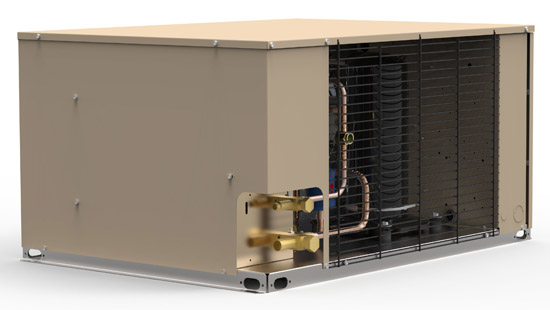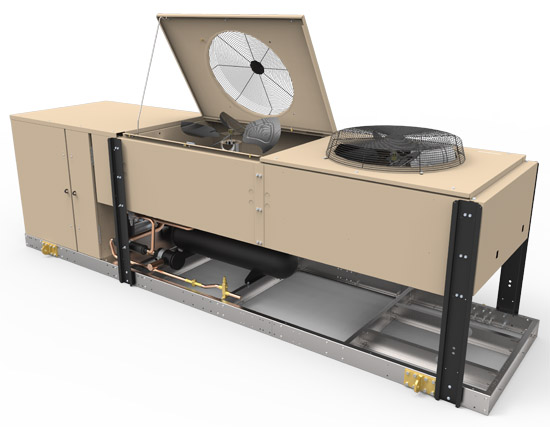 Above: Heatcraft’s new model 1/2 - 6 HP air-cooled condensing unit
Above: Heatcraft’s new model 1/2 - 6 HP air-cooled condensing unit
 Above: Heatcraft’s new model vertical air-cooled condensing unit
Above: Heatcraft’s new model vertical air-cooled condensing unit
A Q&A with Mike Pennington, Director of Engineering for Heatcraft.
Q: How are the new DOE regulations going into effect this year affect the foodservice operator?
Mike Pennington: "Foodservice operators will need to make sure their walk-in coolers and freezers are compliant with the new standards, including enclosure doors and panels, and medium temperature condensing units, as of January 1, 2020. On July 10, 2020, low-temperature condensing units and all unit coolers (evaporators) will also have to be compliant. It is worth noting that refrigeration equipment manufactured prior to the effective dates is still allowed to be installed."
Q: What are the reasons behind these regulations?
MP: "The DOE recently proposed and implemented a set of standards to regulate energy consumption in the United States. The law mandates every product that consumes energy should follow a set standard defined by DOE. All commercial refrigeration equipment manufacturers should comply with the Annual Walk-In Energy Factor (AWEF) rating defined by the DOE. Fundamentally, the ruling will reduce energy consumption and increase efficiency of commercial refrigeration equipment."
Q: As an operator, how is my current equipment affected? Is all my equipment affected?
MP: "All walk-in coolers and freezers (WICF) are affected, but there are some exceptions, specifically:
- Equipment intended solely for scientific, medical or research purposes
- Condensing units solely designed and marketed to serve multiple WICFs or other pieces of refrigeration equipment (e.g., FlexPak), water-cooled condensing units or systems
- WICF with floor space in excess of 3,000 sq. ft.
- Compressorized racks that serve multiple refrigeration loads
- Remote air-cooled condensers and fluid coolers not used for WICF are all exempted.
Q: Do I need to replace my existing cooler/freezers?
MP: "There may be a need to replace existing equipment due to this regulation. Consult your refrigeration expert or refrigeration contractor."
Q: How can I be sure I’m compliant?
MP: "There are several ways to ensure compliance. Review the standard to make sure you’re aware of the requirements. Consult an expert and, if needed, the advice of legal counsel if you’re not sure. Manufacturers are required to manufacture and mark compliant equipment to make it easy for the end user and inspectors to check for compliance."
Q: When building new or replacing equipment, what questions do operators need to ask their contractor?
MP: "If the application is for a walk-in cooler freezer that is smaller than 3,000 square feet, and does not fall under the exemptions mentioned above, ask if the equipment being procured is compliant, and then ask them to explain how they are sure of that. Remember, until July 10, only medium-temperature condensing units manufactured on January 1, 2020 or after are required to meet standards until July 10, 2020, when low-temperature condensing units and all unit coolers must be compliant. If there is something about the application that causes uncertainty regarding whether an application required compliant equipment, ask the contractor to contact an expert, such as Heatcraft Refrigeration Products, to discuss and provide helpful insights for you to then present to your own expert or legal counsel to make a decision."
Q: How has Heatcraft been helping their customers prepare for these new regulations?
MP: "Throughout 2019, Heatcraft crafted and executed a year-long, industry-leading awareness campaign focused on providing subject matter expertise on “all things DOE” while developing inventive marketing materials that included a regulatory microsite with weekly blog articles and a cross-reference tool, a Cross-Reference App (Android & iOS), a build-a-model/nomenclature tool, regulatory news blasts and DOE-specific videos. Heatcraft was the only commercial refrigeration manufacturer to build tools and create content specifically designed to aid customers and internal Heatcraft teams in the transition from legacy to new DOE-compliant equipment before January 1, 2020."
Q: Heatcraft’s new equipment goes beyond just compliance. Can you talk about some of the new features on the equipment?
MP: "Heatcraft DOE-compliant commercial refrigeration equipment, sold under the Bohn, Larkin, Climate Control and Chandler brands, now includes outstanding features that enhance serviceability and unit performance."
Some of the outstanding features in Heatcraft’s new 1/2 to 6 HP air-cooled condensing units include improved valve placement, hinged electrical box door with captive fasteners, a larger electrical box, standard liquid line filter drier and sight glass assembly and an adjustable low pressure switch. Heatcraft’s new vertical air-cooled condensing units include hinged electrical box doors with prop rods to hold doors open, a lighted electrical box, hinged condenser fan venturis and clevis hook lifting brackets.
Click here for information from the U.S. Department of Energy

Above: Find the right model for your needs with the Heatcraft Cross-Reference app.

Above: The Heatcraft Cross-Reference app puts a set of tools in the palm of your hand.



